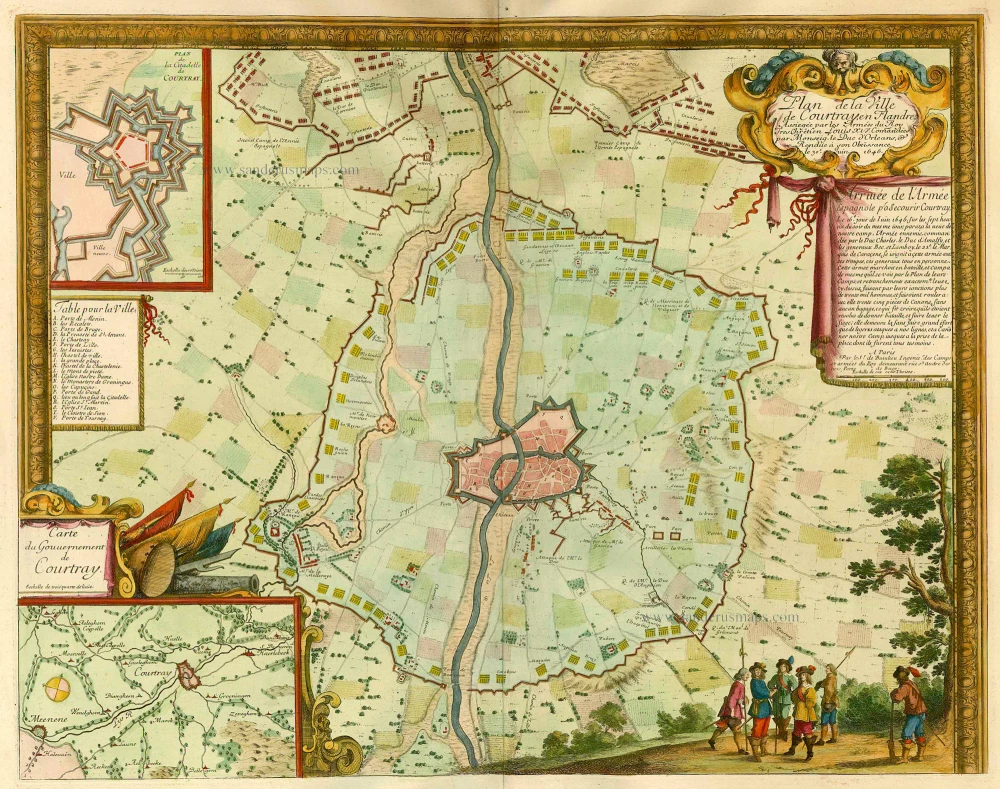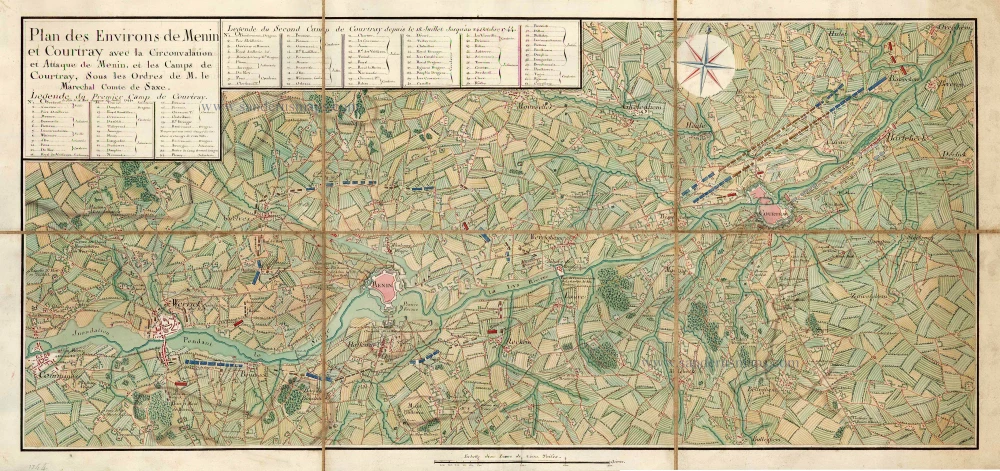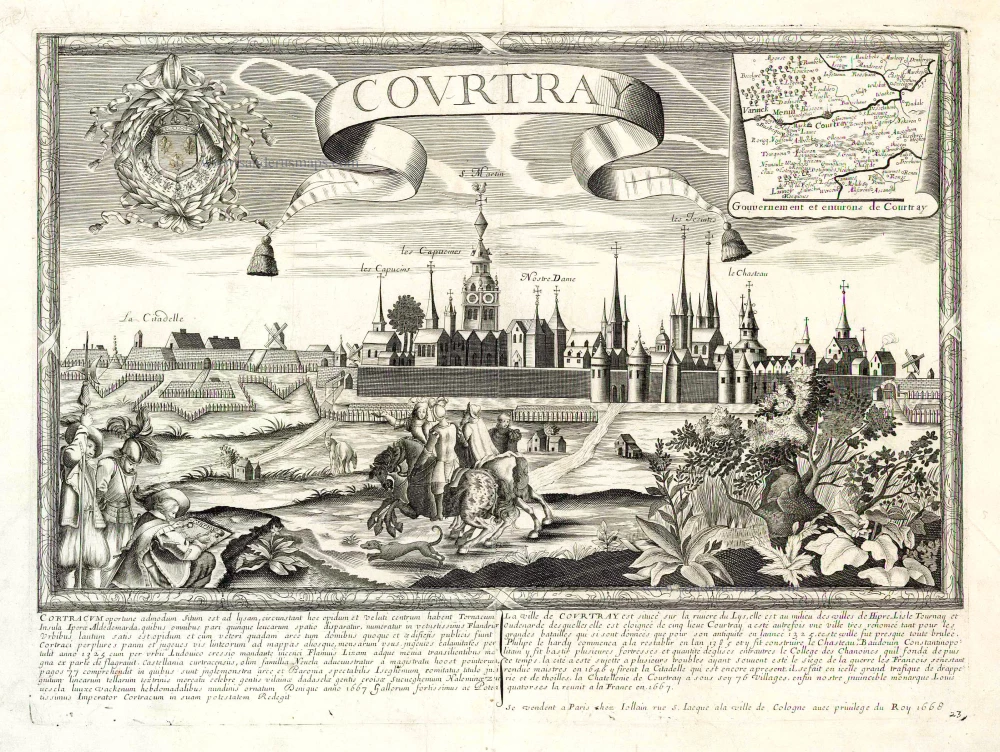Conquest of Kortrijk by the Malcontents, 27 Feb. 1580, by M. Aitsinger, after F. Hogenberg. 1587
Michael von Eitzing (Aitzinger), 1530-1598
Michael von Eitzing, an Austrian nobleman, historian and publicist, was born in 1530 in Ober-Eitzing (Austria). He studied law, mathematics and ancient languages at the University of Vienna. From 1556, he regularly travelled to Flanders and the Spanish Netherlands. He continued his studies in Louvain but was arrested in 1568 and imprisoned for five years in Brussels due to religious troubles. In 1581, he moved to Cologne and died in Bonn in 1598.
Michael von Eitzing left many works, including a renowned volume that states the principles of a genealogical numbering system called an Ahnentafel, which is still in use today. He also wrote and published several historical works, including Novus de Leone Belgico in 1583. It was a richly illustrated account of the wars of religion in the Netherlands with a series of engravings by Frans Hogenberg. It included the first cartographic representation of the Low Countries as Leo Belgicus. The lion motif symbolized the strength of the Netherlands.
Frans (Franz) Hogenberg (1535-1590)
Frans Hogenberg was a Flemish and German painter, engraver, and mapmaker. He was born in Mechelen as the son of Nicolaas Hogenberg.
By the end of the 1560s Frans Hogenberg was employed upon Abraham Ortelius's Theatrum Orbis Terrarum, published in 1570; he is named as engraver of numerous maps. In 1568 he was bannend from Antwerp by the Duke of Alva and travelled to London, where he stayed a few years before emigrating to Cologne. There he immediately embarked on his two most important works, the Civitates published from 1572 and the Geschichtsblätter, which appeared in several series from 1569 until about 1587.
Thanks to such large scale projects as the Geschichtsblätter and the Civitates, Hogenberg's social circumstances improved with each passing year. He died as a wealthy man in Cologne in 1590.
Was gestalt Cortryck in Flanderen von den Malcontents ubereilt, und ingenommen wirtt.
Item Number: 2512 Authenticity Guarantee
Category: Antique maps > Europe > Belgium - Cities
Conquest of Kortrijk by the Malcontents, 27 Feb. 1580, by M. Aitsinger, after F. Hogenberg.
Title: Was gestalt Cortryck in Flanderen von den Malcontents ubereilt, und ingenommen wirtt.
Engraver: Frans Hogenberg.
Date of the first edition: 1583.
Date of this print: 1587.
Copper engraving, printed on paper.
Image size: 190 x 275mm (7.48 x 10.83 inches).
Sheet size: 265 x 350mm (10.43 x 13.78 inches).
Verso: Blank
Condition: Original coloured, excellent.
Condition Rating: A+.
From: Aitsinger M. Belgii Leonis Chorographia. Das ist Ein Newe Landt beschribung des Belgischen Lewen: in XVII Provincien des gantzen Niderlandts außgetheylet. Cologne, Frans Hogenberg, 1587.
Michael von Eitzing (Aitzinger), 1530-1598
Michael von Eitzing, an Austrian nobleman, historian and publicist, was born in 1530 in Ober-Eitzing (Austria). He studied law, mathematics and ancient languages at the University of Vienna. From 1556, he regularly travelled to Flanders and the Spanish Netherlands. He continued his studies in Louvain but was arrested in 1568 and imprisoned for five years in Brussels due to religious troubles. In 1581, he moved to Cologne and died in Bonn in 1598.
Michael von Eitzing left many works, including a renowned volume that states the principles of a genealogical numbering system called an Ahnentafel, which is still in use today. He also wrote and published several historical works, including Novus de Leone Belgico in 1583. It was a richly illustrated account of the wars of religion in the Netherlands with a series of engravings by Frans Hogenberg. It included the first cartographic representation of the Low Countries as Leo Belgicus. The lion motif symbolized the strength of the Netherlands.
Frans (Franz) Hogenberg (1535-1590)
Frans Hogenberg was a Flemish and German painter, engraver, and mapmaker. He was born in Mechelen as the son of Nicolaas Hogenberg.
By the end of the 1560s Frans Hogenberg was employed upon Abraham Ortelius's Theatrum Orbis Terrarum, published in 1570; he is named as engraver of numerous maps. In 1568 he was bannend from Antwerp by the Duke of Alva and travelled to London, where he stayed a few years before emigrating to Cologne. There he immediately embarked on his two most important works, the Civitates published from 1572 and the Geschichtsblätter, which appeared in several series from 1569 until about 1587.
Thanks to such large scale projects as the Geschichtsblätter and the Civitates, Hogenberg's social circumstances improved with each passing year. He died as a wealthy man in Cologne in 1590.












